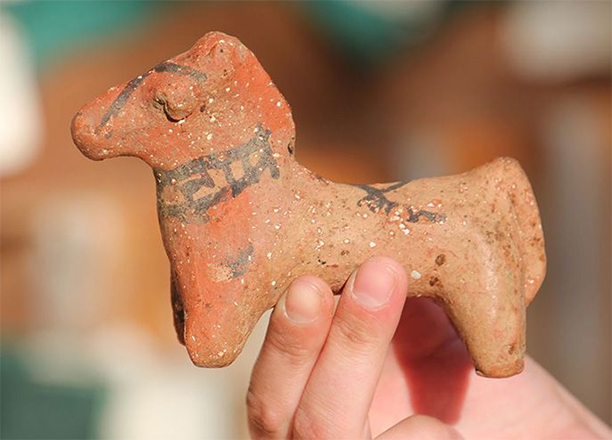You are here
Unfolding Tell Damiyah’s history through the first late Iron Age shrine excavated in the region
By Saeb Rawashdeh - Jan 14,2024 - Last updated at Jan 14,2024

An Iron Age figurine of a horse found at Tell Damiyah by a Jordanian-Dutch archaeological team (Photo courtesy of Leiden University)
AMMAN — The Jordan Valley holds a long history of human occupation. During the Bronze and Iron ages, the Jordan Valley and the overall Southern Levant were under political and economic influence of either the Egyptian or the Mesopotamian dynasties.
Tell Damiyah is located around 500 metres east of the Jordan River in the Zor region and is surrounded by the Katar Hills. It is a significant site in the Central Jordan Valley and it was populated during the Iron Age (1200-600BC).
“These periods without anthropogenic activity are simultaneous with dry climate stages, and it is argued elsewhere that the occupational pattern in the central Jordan Valley is closely related to these environmental factors,” noted Lucas Petit from Leiden University.
During the Iron Age, sites in this region were strategically positioned along key trade routes, both North-South and West-East. According to Petit and the excavations, Tell Damiyah appears to not only have been a major trade hub but also a cultic site, its occupation enduring the test of time even after earthquakes and different climate changes.
Two mud brick buildings from around 700BC were discovered at Tell Damiyah, including several cultic items depicting horse and female figures, found within and in front of the northern building, the other one being identified as a domestic building.
“Evidence for more recent occupation depends on storage pits from the Persian and Hellenistic times and two cemeteries dated to the Byzantine and Ottoman periods,” Petit said, adding that in October and November 2014, the excavation team found a shrine from 700BC.
“Including a platform, the shrine’s rectangular structure measures eight by 6 metres, marking it as the first late Iron Age shrine to be excavated in the region,” Petit noted, adding that the team found a variety of painted terracotta figurines in and around the building, depicting horses and women.
They also found scarabs and seals from Egypt and Iraq, indicating that the shrine was mainly used by merchants and travellers for prayers and offerings.
This conclusion is supported not only by the finds themselves, but also by Tell Damiyah’s location at the intersection of two major trade routes, near a crossing over the river Jordan, the scholar underlined.
“The shrine was probably at the centre of a small village and the inhabitants made textiles and also relied on agriculture and hunting,” Petit stressed, adding that ceramics and written evidence suggest that the village was closely tied to the powerful Neo-Assyrian Empire.
Related Articles
AMMAN — Located strategically on the Jordanian-Palestinian border in the central Jordan Valley, and at the confluence of the Zarqa and Jorda
AMMAN — During the ninth season of excavation at Tell Damiyah (Damiyah Hill) in the central Jordan Valley, a joint project of the Yarmouk Un
AMMAN — The places of worship tend to have different architectural shapes through the history of religious practice.

















